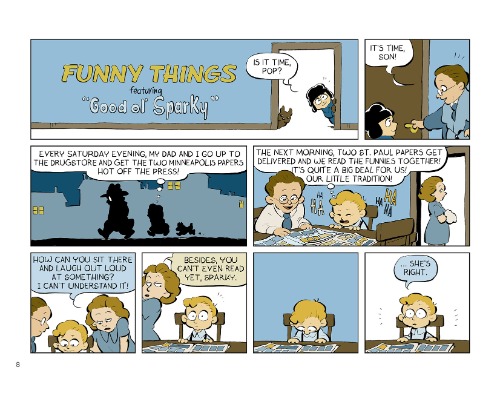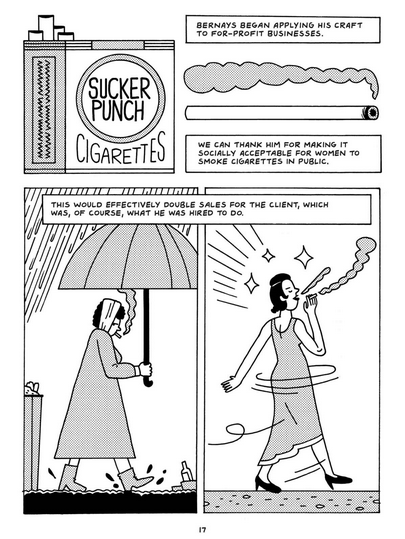Summer Vacation Assignment: Book Report
Skip to commentsWhere I’m Coming From, The Buildings are Barking, Funny Things, Poor Helpless Comics!, The Talk, The He-Man Effect, You’re Not A Real Parent Until…, Thorn, and Gladys Parker are reviewed by various sites.
Following are some book reviews of recently released or forthcoming books of interest.
[F]or many decades, the comics section was a little window into the soul of its distribution community, all drawn together by the gold standard of nationally syndicated cartoon strips. Like most forms of media, the subjects of cartoon strips and their creators were overwhelmingly White. That’s what made Barbara Brandon-Croft’s Where I’m Coming From — the first nationally syndicated cartoon strip by and about Black women — such a breakthrough achievement. A new publication of the same name from Drawn and Quarterly Press compiles highlights from the strip between 1991 and 2005 (the years of its national syndication), as well as frontmatter including the artist’s pitch letters to major publications, and essays on the work’s importance.

Sarah Rose Sharp, at Hyperallergic, reviews Where I’m Coming From by Barbara Brandon-Croft.
… So coming to The Buildings Are Barking: Diane Noomin in Memoriam is a bit of change of pace. Noomin, of course, was Griffith’s wife of over 40 years, who passed away last year from uterine cancer. Although the title implies it to be a recollection or recounting of what Noomin did throughout her life, it’s just as much a therapy session for Griffith as he tries to process his (very understandable) grief. Between those two aspects, though, we do see much of what their relationship was and what they meant to each other.
Interstingly, the art in the book is by both Griffith AND Noomin.

Italian artists Debus (The Importance of Being Earnest) and Matteuzzi (Banksy) imitate the style of Charles M. Schulz (1922–2000) in this clever reconsideration of the cartoonist and his particular genius. Structured like the newspaper funnies that inspired Schulz as a child—six black-and-white strips punctuated by full-page color spreads—the narrative achieves the comical downbeat rhythm that made Peanuts a surprise hit. Narrating from his usual table at the California skating rink he built after achieving fame and fortune, Schulz relates a shy, neurotic boyhood in St. Paul, Minn…

Publishers Weekly reviews Funny Things: A Comic Strip Biography of Charles M. Schulz.
Subitzky’s work as National Lampoon contributing editor included roughly 100 comic strips, some multi-page, and approximately the same number of articles. Poor Helpless Comics! will include a selection of Subitzky’s comics, cartoons, humor writing, and information about his work on TV and in advertising. Subitzky also appeared in the documentary Drunk Stoned Brilliant Dead: The Story of the National Lampoon.
The book’s contents are put in context with an interview with Subitzky conducted by Mark Newgarden…

More news than review is ICv2’s Johanna Draper Carlson on this Fall’s Poor Helpless Comics! by Ed Subitzky.
Before Darrin Bell created the comic strip “Candorville” and became a Pulitzer Prize-winning editorial cartoonist, he was a kid who wanted to think the best of the world but kept getting tripped up by its racism.
Like all great editorial cartoonists, Bell minimizes overt commentary, making satiric jabs, instead, with brevity, wit, insight and humanity.

Chris Barsanti for The Minneapolis Star Tribune reviews The Talk by Darrin Bell.
Keep scrolling down the page and read their review of
The He-Man Effect: How American Toymakers Sold You Your Childhood By Brian “Box” Brown.
Somehow triangulating a storytelling space between silly celebratory throwbacks like Netflix’s “The Toys That Made Us” series and Chomsky-an deconstructions of official narratives, Brian “Box” Brown’s “The He-Man Effect” is less the tale of one beloved 1980s toy than the pop history of an industry. Brown argues that the persuasion tactics Edward Bernays, the Freudian founder of modern public relations, used to convince Americans to support the CIA-led 1954 Guatemala coup d’état also helped Disney and other corporations push GI Joes to the masses.

“As an Aussie immigrant, I’ve always marvelled at the varied responses my New Yorker friends give in response to the prompt, ‘You’re not a real New Yorker until…?’ My writing partner saw me performing the bit at a club one night and said they’d make a pretty funny series of cartoons for the New Yorker.
“By the night’s end, we’d written about 100.
For his first book in the series, You’re Not a Real Parent Until…, Jason turned his comedic gaze to the inherently bizarre life of raising a child. But he’s not mocking it from a place of cruelty, though. “We made it to help parents feel less alone in the challenging journey of parenting, from babies to toddlers, tweens, teens and beyond,” he explains.

At Creative Boom Dom Carter interviews co-author/cartoonist and reviews the book
You’re Not A Real Parent Until… by Scott Dooley and Jason Chatfield.
This won’t be the first time that the Thorn strips, which feature alternate versions of Thorn, Fone Bone, and other characters from the Bone comic series in an entirely different storyline from the one audiences are already familiar with, have been reprinted.
The new edition will be titled Thorn: The Complete Proto-Bone College Strips from 1982-1986, And other Early Drawings, and will be the first time all of the strip has been reprinted in its entirety; additionally, the book will feature other contemporaneous work, including early drawings of the Bone characters, as well as essays and interviews. The title will be available in both hardcover and paperback editions, and will launch on Kickstarter in October.

Not a review. Graeme McMillan at Popverse gives more news about the upcoming
Thorn: The Complete Proto-Bone College Strips from 1982-1986, And other Early Drawings by Jeff Smith.
(Since I am looking forward to this, you’ll be seeing regular updates about this comic strip collection.)
“Mopsy” got its name thanks to cartoonist Rube Goldberg, who once told Parker her hair looked like a mop. Her style, though, was pure Parker, who also worked as a fashion designer in Hollywood in the ’30s and ’40s, and illustrated her own newspaper ads for department stores that carried her line.
The Gladys Parker book is a beautiful volume that combines her biography with reproductions of her comic strips, photographs of the fashionable artist, and examples of her fashion styles. It’s the latest in a series of histories of early women cartoonists Robbins has written including “Flapper Queens: Women Cartoonists of the Jazz Age” and “The Brinkley Girls: The Best of Nell Brinkley’s Cartoons from 1913-1940.”
Next up is Grace Drayton, Robbins said.

Another amalgamation of author interview and book review from Peter Larsen and The Orange County Register on Gladys Parker: A Life in Comics and Passion for Fashion by Trina Robbins.


Comments
Comments are closed.